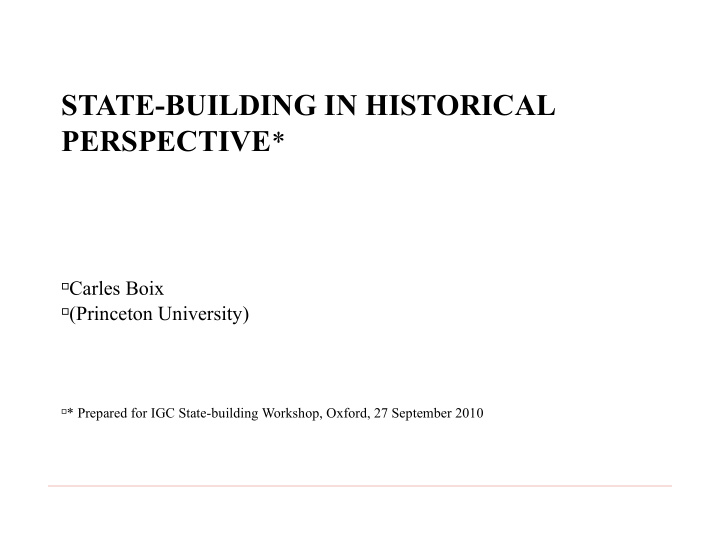



STATE-BUILDING IN HISTORICAL PERSPECTIVE * o Carles Boix o (Princeton University) o * Prepared for IGC State-building Workshop, Oxford, 27 September 2010
DEFINITIONAL ISSUES Main focus on: 1/ origins of state; 2/ territorial size of states. o Standard definition: state as individuals/organization with monopoly of coercion o (Weber 1968). Still, the definition is a contested one: o state = modern national state (absolute sovereignty over territory; impersonal n institutions; ruler defends a separate legal order; inter-state recognition) versus a variety of political orders (empires, city federations, feudal networks) n The choice of the concept has implications for measurement of outcome to be o explained and seems to be correlated with preferred explanatory variable (war among the former; institutional/bureaucratic choices, ideas, trade among the latter).
FROM STATELESS SOCIETIES TO POLITICAL INSTITUTIONS (1) Until 1970s-1980s: o a/ normative approach (contractarian theorists); n b/ sociological theories (Marxist [Wallerstein 1974]; functionalist [Wittfogel; Hardin n 1989; partly Olson 1993]; war-making (Hintze, Tilly)] First generation of PE models of state formation: state as a contract between two parties o (producers / looters) exchanging rents for protection. Problems: bandit’s credible commitment; exogeneity of parties’ initial resources; lack of account of distributional consequences. Second generation of PE models of state formation (North 1981, ch. 3; Olson 1993; Olson o 2000; Konrad & Skaperdas 2006): instead of looting, the “specialist in violence” becomes a ‘stationary bandit’, extracting rents and protecting producers. States break down following sudden price shocks, shifts in military technology, changes n in bandit’s discount rate (Bates 2008)
FROM STATELESS SOCIETIES TO POLITICAL INSTITUTIONS (2) Problems of second generation models: o Sparse empirical validation n Imprecision about conditions under which non-feasible cooperation is feasible n Exclusion of ‘republican’ solution n Lack of analysis of redistributive effects n Lack of attention to institutional mechanisms to sustain political order among coalition n of rulers
FROM STATELESS SOCIETIES TO POLITICAL INSTITUTIONS (2) Problems of second generation models: o Sparse empirical validation n Imprecision about conditions under which non-feasible cooperation is feasible n Exclusion of ‘republican’ solution n Lack of analysis of redistributive effects n Lack of attention to institutional mechanisms to sustain political order among coalition n of rulers A potentially more encompassing model … o Individuals cooperate (without third-party enforcer) as long as economic conditions n are relative equal . [ Foraging communities ] After a biased technological (economic) shocks introduces inequality, ‘spontaneous’ n cooperation impossible, individuals sort out into different types, conflict becomes generalized. [ Agrarian Revolution ] Three outcomes are feasible: permanent conflict; monarchy; self-government. [ State n Formation ] Each solution is a function of military technology and affects the final distribution of n income (in interaction with the initial economic shock).
BIOGEOGRAPHIC CONDITIONS AND THE INTRODUCTION OF AGRICULTURE
AGRICULTURAL REVOLUTION AND STATE FORMATION
MILITARY TECHNOLOGY AND POLITICAL REGIME Shifts in military technology change the balance of power and political institutions: o Bronze weapons led to more hierarchical societies: emergence of Mesopotamian n states ca. B.C. 3,500. Two-wheeled chariots led to ‘feudalization’ around 1,800 BC. n Introduction of iron & Greek/Roman democracy (Andreski 1968, McNeill 1981) n Stirrup * Terrain: Variation in European & Japanese feudalism n Gunpowder and modern state. n
STATE FORMATION IN EUROPE War-making & state-making (Hintze 1902, Tilly 1990): o Modern technologies (canon) behind process of political concentration & n centralization in Europe since ca. 1450 Variation in timing & size due to ‘coercion/capital’ (land/capital ?) ratio, n army/navy, endogenous institutions Final convergence by 1870 n From state-making to national identity: o In Tilly (also Levi), war-making changes the nature of state institutions. But n non-war explanations of national identity dominate in the literature: economic modernization (Gellner 1983), ideational processes (B. Anderson 1983), elite strategies (Laitin 1998) From national identity to state-making: o Ethnic fractionalization and efficiency (Alesina et al 1999); inter-group n inequality & civil wars (Cederman et al 2010). Institutional imbalances (due to colonial legacies) and instability (Wilkinson) n
STATE FORMATION OUTSIDE EUROPE Herbst (2000) on Africa. H extends Tilly’s arguments: o Population density & natural barriers explain weak states n The colonial legacy and the Westphalian system of inter-state recognition have n reinforced the fragility of states Centeno (2002) on Latin America: o Internal splits within the ruling strata & the stabilizing influence of European n powers also produced weak states Soifer (2008, 2010) offers a long-run comparison of several LA states: relative n strong states (i.e Chile) were the result of the victory of a centralizing Liberal elite ca. 1840-1850 Hui (2004, 2005) compares China’s unification with Europe’s fragmentation. o
ALTERNATIVE ACCOUNTS The construction of bureaucratic structures preceded the successful adoption of o gunpowder (Strayer 1970). Societal coalitions explain the type of state (empire, city-state, national state) adopted o in Europe – but competitive pressures finally led to historical convergence (Spruyt 1997). Analytical models stressing state size as an outcome of trade gains (Friedman 1977) o & of trade gains – public goods trade-offs (Alesina and Spolaore 2003). Two concerns: exogeneity of preferences; 20th-century waves in state formation coincide with imperial implosions. Agent-based models (Cederman 1997, 2003). o
Recommend
More recommend